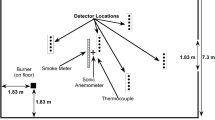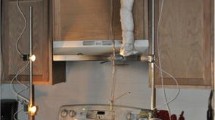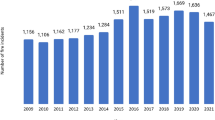Abstract
Operation of domestic smoke detectors (photoelectric and ionization) has been investigated in a typical Melbourne dwelling using smoke from smoldering hardboard and artificial smoke generated at three widely different rates. Detector performance was assessed according to the escape time offered by its operation, this being based on the criterion of visibility needed to effect escape. Under these test conditions detectors located in bedrooms performed adequately only when smoke originated in the same room; they provided poor escape times for smoke originating elsewhere. Also, ionization detectors usually provided adequate escape times only when smoke travel from the source room to the rest of the dwelling was restrained by small door openings, since it then took longer for visibility to be lost. Photoelectric detectors were generally more effective than ionization detectors, as expected for smoldering conditions, and when located in the hallway provided adequate escape times for most conditions of size and location of smoke source.
Similar content being viewed by others
References
Johnson, P. F., “Domestic Fire Detectors. The Australian Experience,”Fire Journal (Aust), Vol. 5, No. 2, 1981, p. 27.
Brown, S. K. and Martin K. G., “Building Fires in Melbourne. Investigation of Damage of a Sample of Fire Sites,” CSIRO Division of Building Research Report, Melbourne, 1981.
Australian Fire Protection Association, “House Fire Detection Systems. General Guidelines,” Bulletin No. 208, Melbourne, 1980.
Underwriters Laboratories, “Standard for Safety—Single and Multiple Station Smoke Detectors,” UL217, 2nd Edn. 1980.
Johnson, P. F. and Moulen, A. W., “Fire Detection in a Typical Cottage. A Report of Tests Conducted at Springwood, New South Wales,” Technical Record 453, Department of Housing and Construction, Sydney, 1979.
National Fire Protection Association, “Los Angeles Fire Department Tests,”NFPA Quarterly, Vol. 56, No. 3, 1963.
Kennedy, R. H., Riley, K.W.P. and Rogers, S. P., “A Study of the Operation and Effectiveness of Fire Detectors Installed in the Bedrooms and Corridors of Residential Institutions,” Building Research Establishment Current Paper CP 26/78, Fire Research Station, Borehamwood, 1978.
Bukowski, R. W. and Bright, R. G., “Results of Full Scale Fire Tests with Photoelectric Smoke Detectors,” National Bureau of Standards Internal Report IR 75–700, Washington, 1975.
Bukowski, R. W., “Field Investigation of Residential Smoke Detectors,” National Bureau of Standards Internal Report IR 76–1126, Washington, 1976.
Harpe, S. W., Waterman, T. E. and Christian, W. J., “Detector Sensitivity and Siting Requirements for Dwellings—Phase 2 (Indiana Dunes Tests),” National Bureau of Standards, Report GCR-77–82, Washington, 1977.
Silcock, A., Robinson, D. and Savage, N. P., “Fires in Dwellings — an Investigation of Actual Fires. Part II: Hazards from Ground-Floor Fires,” Building Research Establishment Current Paper CP 80/78, Fire Research Station, Borehamwood, 1978.
Commonwealth Scientific and Industrial Research Organization, “CSIRO Low Energy Consumption House. Bulletin number 1,” CSIRO Division of Mechanical Engineering, Information Sheet 12/B/4, Melbourne, 1978.
Department of Housing and Construction, “Approval Test Procedures for Fire Detection Systems,” Document No. 002, Issue 3, Melbourne, 1976.
Brown, S. K. and Martin, K. G., “Corner-Wall Burns of Linings and Claddings. Further Comparison to the Early Fire Hazard Test,” CSIRO Division of Building Research Report, Melbourne, 1983.
Ramsay, G. C. and Dowling, V. P., “Protocol for the Assessment of the Fire Behaviour of Furniture Using Large Flaming Ignition Sources. Part 1: Upholstery Combinations,” CSIRO Division of Building Research Report, Melbourne, 1983.
Pistor, M., “On a Scattered-Light Measuring Device for Use in Testing Types of Smoke Detectors,” National Bureau of Standards Report NBSIR 76–1087, Washington, 1976.
Harpe, S. W. and Christian, W. J., “Development of a Smoldering-Fire Test for Household Smoke Detectors,”Fire Journal (USA), Vol. 73, No. 3, 1979, p. 48.
Brown, S. K. and Martin, K. G., “A Review of the Visibility Hazard for Smoke in Building Fires,” CSIRO Division of Building Research Report, Melbourne, 1981.
Jin, T., “Visibility Through Fire Smoke,”Journal of Fire and Flammability, Vol. 9, No. 2, 1978, p. 135.
Nober, E. H., Pierce, H. and Well, A., “Waking Effectiveness of Household Smoke and Fire Detection Devices,” National Bureau of Standards Report GCR-83–439, Washington, 1983.
Author information
Authors and Affiliations
Additional information
Reference: P. F. Johnson and S. K. Brown, “Smoke Detection of Smoldering Fires in a Typical Melbourne Dwelling,”Fire Technology, Vol. 22, No. 4, November 1986, p. 295.
Rights and permissions
About this article
Cite this article
Johnson, P.F., Brown, S.K. Smoke detection of smoldering fires in a typical Melbourne dwelling. Fire Technol 22, 295–310 (1986). https://doi.org/10.1007/BF01038242
Received:
Accepted:
Issue Date:
DOI: https://doi.org/10.1007/BF01038242




